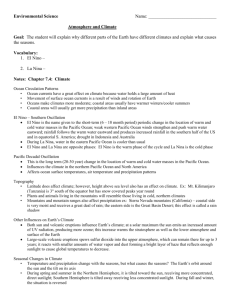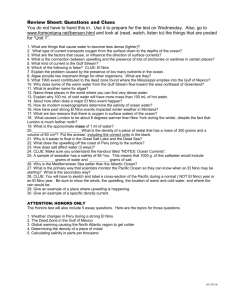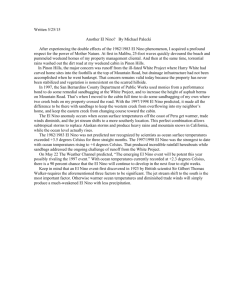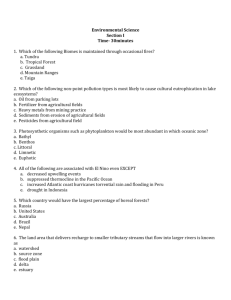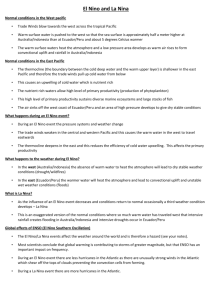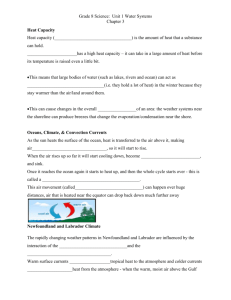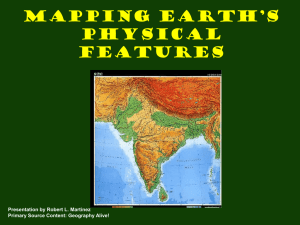Environmental Science Name: Atmosphere and Climate Goal: The
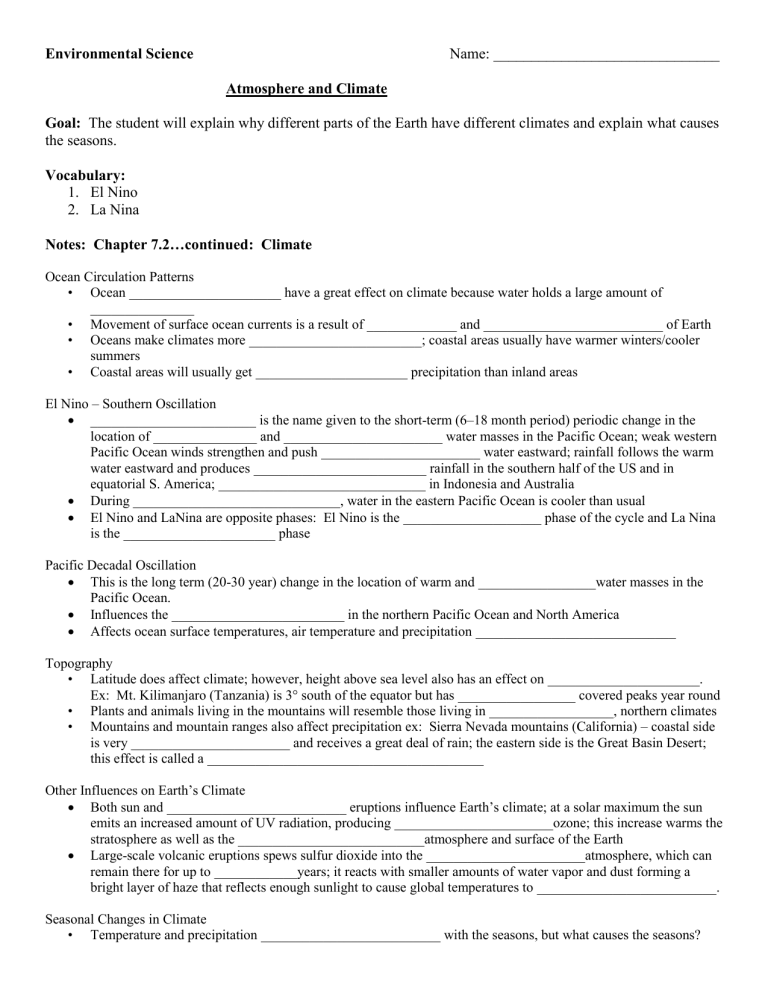
Environmental Science Name: ______________________________
Atmosphere and Climate
Goal: The student will explain why different parts of the Earth have different climates and explain what causes the seasons.
Vocabulary:
1.
El Nino
2.
La Nina
Notes: Chapter 7.2…continued: Climate
Ocean Circulation Patterns
• Ocean ______________________ have a great effect on climate because water holds a large amount of
_______________
• Movement of surface ocean currents is a result of _____________ and __________________________ of Earth
• Oceans make climates more _________________________; coastal areas usually have warmer winters/cooler summers
• Coastal areas will usually get ______________________ precipitation than inland areas
El Nino – Southern Oscillation
________________________ is the name given to the short-term (6–18 month period) periodic change in the location of _______________ and _______________________ water masses in the Pacific Ocean; weak western
Pacific Ocean winds strengthen and push _______________________ water eastward; rainfall follows the warm water eastward and produces _________________________ rainfall in the southern half of the US and in equatorial S. America; ______________________________ in Indonesia and Australia
During ______________________________, water in the eastern Pacific Ocean is cooler than usual
El Nino and LaNina are opposite phases: El Nino is the ____________________ phase of the cycle and La Nina is the ______________________ phase
Pacific Decadal Oscillation
This is the long term (20-30 year) change in the location of warm and _________________water masses in the
Pacific Ocean.
Influences the _________________________ in the northern Pacific Ocean and North America
Affects ocean surface temperatures, air temperature and precipitation _____________________________
Topography
•
Latitude does affect climate; however, height above sea level also has an effect on ______________________.
Ex: Mt. Kilimanjaro (Tanzania) is 3° south of the equator but has _________________ covered peaks year round
•
Plants and animals living in the mountains will resemble those living in __________________, northern climates
• Mountains and mountain ranges also affect precipitation ex: Sierra Nevada mountains (California) – coastal side is very _______________________ and receives a great deal of rain; the eastern side is the Great Basin Desert; this effect is called a ________________________________________
Other Influences on Earth’s Climate
Both sun and __________________________ eruptions influence Earth’s climate; at a solar maximum the sun emits an increased amount of UV radiation, producing _______________________ozone; this increase warms the stratosphere as well as the ___________________________atmosphere and surface of the Earth
Large-scale volcanic eruptions spews sulfur dioxide into the _______________________atmosphere, which can remain there for up to ____________years; it reacts with smaller amounts of water vapor and dust forming a bright layer of haze that reflects enough sunlight to cause global temperatures to __________________________.
Seasonal Changes in Climate
•
Temperature and precipitation __________________________ with the seasons, but what causes the seasons?
The Earth’s ________________________ around the sun and the tilt on its axis
•
During spring and summer in the Northern Hemisphere, it is tilted ______________________ the sun, receiving more concentrated, direct sunlight; Southern Hemisphere is tilted _____________________ receiving less concentrated sunlight. During fall and winter, the situation is reversed
•
Our ______________________seasons do not occur in the tropics (close to the equator); they have high constant temperatures throughout the year and receive the most direct sunlight year round
Lesson Reflection:
Using the picture of the world map and the overhead of the surface water temperatures for the world, to the best of your abilities, color in the map showing where the surface water is warm and where it is cool. Be sure to include a key.
Assessment:
1.
What is the difference between El Nino and La Nina?
2.
Explain what causes the seasons.
Active Reading: Climate and Climate Change
Lesson Extension (Technology/Application/Connection to Real World):
Watch PBS video : The Ocean and Weather: El Nino and La Nina (3:00 min)
